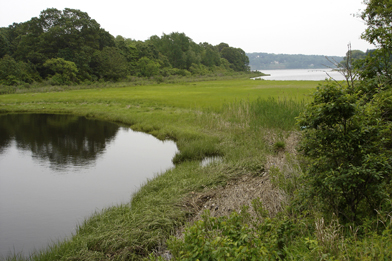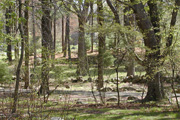A rare look at some regional native plant and animal habitats
The Arboretum includes tracts of land which are not dedicated to specific plant collections, but rather are preserved as natural or managed areas. These areas offer a rare look at some of the region's habitats of native plants and animals.
Bolleswood, Goodwin and Mamacoke Island
Three tracts, totaling about 200 acres, are dedicated as Natural Areas. The oak and hemlock forested Bolleswood Natural Area is located west of the Arboretum Pond; the Goodwin Natural Area is north of Gallows Lane; and the rocky, wooded, 40-acre Mamacoke Island in the Thames River is attached to the mainland by a small tidal salt marsh. Please note: if you wish to visit Mamacoke Island, consult a tide chart and plan your trip to take place near low tide.

Arboretum policy calls for no manipulation other than the maintenance of trails, so these areas remain as undisturbed by human activity as possible. (A brief description of the natural vegetation follows below.)
Natural areas serve a number of significant functions and are an integral part of the Arboretum's identity and mission. Scientifically valuable, natural areas are the "controls," the "standards" or "common denominators" by which serious land management programs can be judged and evaluated. They preserve samples of vegetation types, and serve as examples of processes of natural change and development over time. The Bolleswood natural area is a site of long-term vegetation and breeding bird surveys begun in the early 1950s and still in progress. Similar long-term studies are in progress on the Mamacoke Island tidal marshes. A complete Arboretum research bibliography is available for reference.
Educationally valuable, natural areas are "outdoor museums" for the exhibition of the plant, animal and mineral worlds. They should be treated with the same care and consideration as historical monuments or exhibits in museum halls. Both Arboretum natural areas are important components of the biology program of the College.
Culturally valuable, natural areas are assuming more and more worth in a crowded world where space and privacy are becoming rare and cherished commodities. Both students and visitors appreciate the solitude and natural beauty found in these areas.
Natural History and Biodiversity
The Connecticut College Arboretum is located in southeastern Connecticut, about 5 miles inland from Long Island Sound. Recent glaciation (about 26,000 years ago) has greatly affected the landscape in this area. Our rocky soil, glacial eratics (large boulders), the Connecticut coastline, and our numerous wetlands are all direct results of this glaciation. The glacier scoured our hill tops and deposited till in our valleys. The Thames River, beside which we are situated, also has glacial origins. Bedrock geology is dominated by granites, schists and gneisses.

There is considerable diversity in plant communities within the Arboretum. Our forests are part of the central hardwoods vegetation zone. Crest sites are dominated by chestnut oak (Quercus prinus), and huckleberry (Gaylussacia baccatta). Midslope forests are dominated by oaks (Quercus velutina, Quercus alba), maples (Acer rubrum, Acer saccharum) and black birch (Betula lenta). Typical shrubs include mountain laurel (Kalmia latifolia) and arrowwood (Viburnum dentatum var. lucidum). On lower slopes, tuliptree (Liriodendron tulipifera), white ash (Fraxinus americana) and American beech (Fagus grandifolia) are common.
Within the Arboretum there are many wetland types, including forested wetlands, bogs and tidal marshes. Red maple (Acer rubrum) is the dominant tree in freshwater swamps, with sweet pepperbush (Clethra alnifolia) and spicebush (Lindera benzoin) the most typical shrubs. Skunk cabbage (Symplocarpus foetidus), marsh marigold (Caltha palustris), and pitcherplant (Sarracenia purpurea) can also be found in these areas.

The Arboretum also contains a tidal salt marsh. Mamacoke Marsh, situated on the Thames River, is one of the few unditched marshes left in Connecticut. Tidal marshes are incredibly productive systems both in terms of vegetation and fauna, and act as a nursery for large numbers of marine organisms. The vegetation often occurs in bands corresponding to small differences in elevation above the mean high tide. On Mamacoke, distinct belts of smooth cordgrass (Spartina alterniflora), salt meadow cordgrass (Spartina patens), marsh elder (Iva frutescens), and switchgrass (Panicum virgatum) can be seen clearly.
Human History and Ecology
In studying the ecology of an area, past human history is a crucial factor. Prior to colonial settlement, fires intentionally set by Native Americans were common. This opened the understory, making travel easier, and the re-sprouting plants provided forage for game animals. This fire-tolerant forest was dominated by oak (Quercus spp.), hickory (Carya spp.) and chestnut (Castanea dentata). With colonial settlement came cultural fire suppression. This has lead to a significant increase in the forest understory as well as an increase in fire-sensitive trees such as birches (Betula spp) and hemlocks (Tsuga canadensis). The colonial era also saw the cutting of over 80% of the eastern forest. White pines (Pinus strobus) were used as ships' masts, while hickory was selected as timber for its hard, straight grain.
Although incredibly rocky, this land was used for agricultural purposes, especially pasturage. In the mid to late 1800's, much of this land was abandoned in favor of frontier development. The vegetation change of these 'old fields' into the regrowth forest helped determine what species are currently present. Eastern red cedar (Juniperus virginiana) is a small tree not browsed by domestic animals and consequently is a very common species in abandoned pastures.
Natural disturbance also plays a crucial role in understanding the current natural vegetation. The 1938 hurricane blew down trees throughout large areas of New England, including the Arboretum. This gave way to a new round of vegetation change and produced mound and cradle topography over much of the Arboretum. In the 1930's, the chestnut blight removed chestnut as a forest tree, and today the hemlock woolly adelgid continues to defoliate and kill our native eastern hemlock.